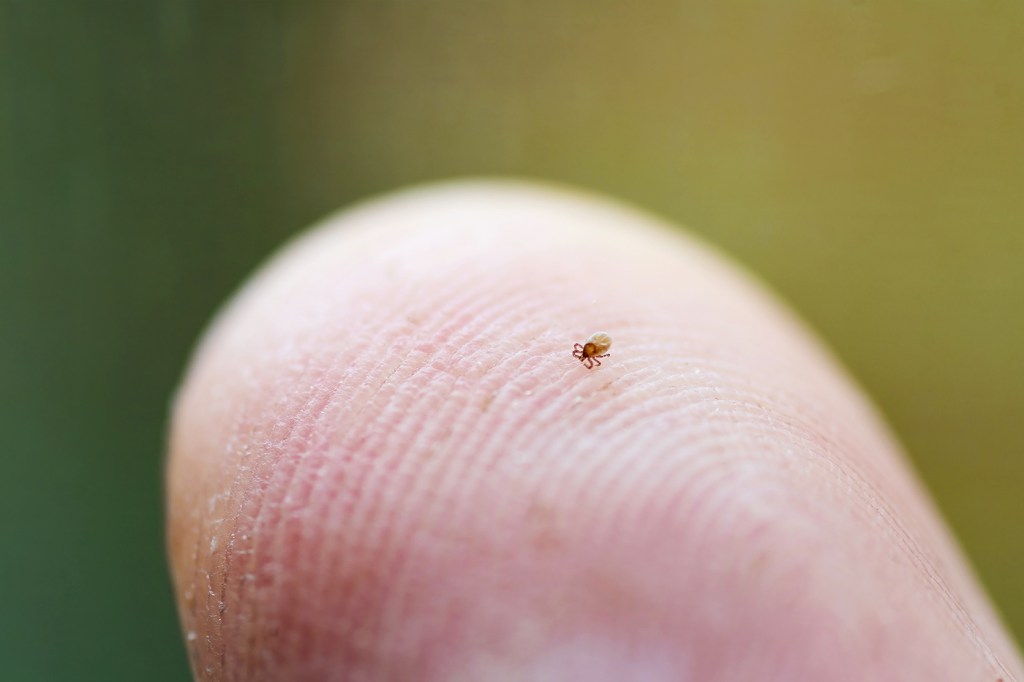The teeny, tiny ticks that cause the most Lyme disease are out

Summer is here, meaning it’s time to break out the tick protection along with the sunscreen.
Although the deer ticks that transmit Lyme disease are active whenever it’s above freezing, they are not only out now, they are so tiny—the size of a pencil tip or poppy seed—they are practically invisible.
Why is tick exposure so dangerous at this time of year?
That lack of visibility gives them stealth disease-transmitting powers.
“This is when a lot of people get infected,” says Northeastern University professor Kim Lewis, director of the university’s Antimicrobial Discovery Center.
People are outdoors, enjoying backyards, parks and hiking trails. But if they can’t see the tick that bit them to remove it with a pair of tweezers, they give the tiny ticks more time to feed on them and transmit pathogens with their saliva.

No wonder then that Massachusetts state public health officials say the majority of cases of tick-borne disease, including Lyme disease, occur from June to August.
At this stage of development, deer ticks are known as nymphs. They will hang around until August, when if they are lucky enough to get a blood meal they will turn into adults, says Larry Dapsis, entomologist with the Cape Cod Cooperative Extension.
Adult deer ticks actually are more likely to carry the bacterium, Borrelia burgdorferi, that causes Lyme disease, Dapsis says. But being more visible—they are sesame seed-sized—the adults are more likely to be spotted and pulled off before they can do any damage.
“The infection rate for nymphal ticks is 20% compared to the adult stage, which is 50%. But the nymphs are responsible for 85% of all tick-borne diseases,” Dapsis says.
The nymphs emerge in mid- to late-May and tend to lurk in the leaf litter, unlike the adults that perch on grasses and shrubs that are knee high.
What can people do to protect themselves from Lyme and other tick-borne diseases?
Dapsis says there are a number of things people can do to protect themselves from becoming a meal for the tiny arthropods, the terrorists of the forest floor, and he has enumerated them in a series of short videos on fighting tick-borne disease.
The first line of defense is to spray clothing–especially footgear—with permethrin, a medication and insecticide that Dapsis says The Food and Drug Administration deems safe for attire used by adults and clothing.
“Spray shoes until they are visibly wet” and spray again after four weeks, Dapsis says.
Dose pants to mid-thigh on the exterior and from the knee down inside, he says.
Spray clothes while they are off your body and don’t apply permethrin to skin.
A tick on a surface treated with permethrin will start lifting its eight legs like it’s got a hot foot, Dapsis says. “After 60 seconds of exposure, it’s a goner.”
People who aren’t interested in the do-it-yourself approach to permethrin treatment can purchase pre-treated clothing or pay for a service to treat their clothes, such as Insect Shield.
Dapsis also advises people coming in from outdoors to throw their clothes in the dryer for 20 minutes. The heat will kill moisture-loving ticks.
Tick checks are also important, but when the tiny nymphs are out the best approach is to use fingertips to feel ticks that may be too small to see, Dapsis says.
Sticking to the center of trails and avoiding bushy vegetation can help people avoid contact with ticks, Lewis says.
In the summer “they’ll be essentially pretty much everywhere, crawling around, looking for prey. If you are on a path in the woods, you are considerably better off than veering off the path,” he says.
